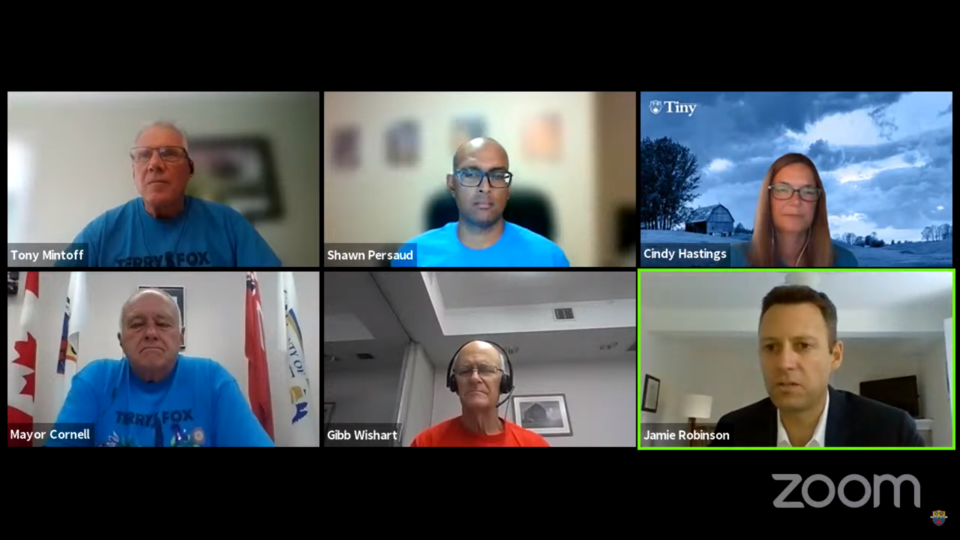A county-wide Municipal Comprehensive Review (MCR) estimated North Simcoe to have a proposed density of 32 people and jobs per hectare, which was far above what Tiny Township could sustain, according to a recommendation from consultants on the topic.
Jamie Robinson, of MHBC Planning Urban Design & Landscape Architecture, presented considerations for recommendation at a recent committee of the whole meeting, where he informed council of the project and its findings.
“What the big picture of this is all about,” Robinson began, “is ensuring from a planning perspective that there’s sufficient land that’s designated in the municipality to accommodate the growth projections that the township ends up receiving at the end of the day.
“That’s the finish line, and we’re a long way from the finish line at this point in the process.”
The MCR is intended to bring the official plans for the 16 local area municipalities in Simcoe into conformity with the County Growth Plan, in accordance with the Provincial Growth Plan: A Place To Grow: Growth Plan for the Greater Golden Horseshoe.
In the process, local planning will get more detailed through the overall pattern of development and environmental management in the county, for which growth management is one component. The province has required Simcoe County to plan for 555,000 people and 198,000 jobs by 2051, and a land needs assessment to determine growth in existing primary settlement areas is part of the allocation necessary.
“To cut to the chase, what we’re suggesting here,” said Robinson, “the county official plan currently includes a density target of 32 persons and jobs per hectare -- and again, that’s a target. We’re suggesting that it be reduced for Tiny Township. And there’s a couple of reasons for that.
“The main reason is that in Tiny Township, there is no (sewage) servicing,” explained Robinson.” “There’s two communities, Wyevale and Perkinsfield, that do have water systems, but it’s difficult to create a diversified housing stock in a more dense form of development without (full) servicing in place.”
Robinson stated that a simple calculation based on Tiny zoning bylaws was made which suggested that the township could propose a much lower number of 12 people and jobs per hectare, instead of the county estimate of 32 people and jobs per hectare by 2051.
“The minimum lot size is 2,000 square metres, a hectare is 10,000 square metres, and the average household size based on (2016) census information is 2.4 persons per household,” said Robinson. The hamlet Residential One (HR1) Zone in the zoning bylaws was used for the basis of the minimum lot size “to accommodate a septic system and in some cases a well in those unserviced areas.”
Coun. Cindy Hastings asked Robinson about the high bar set by the county, if Tiny couldn't reach that density target.
“We just felt that the 32 units per hectare is not achievable, so we need something that’s more realistic for the unique set of circumstances that Tiny has,” replied Robinson. “This is a number that applies for settlements that do have servicing. Severn Township, for example, has Coldwater and Washago which run full services, they have the same 32 unit per hectare as you folks do.
“There needs to be a ‘Made in Tiny’ solution.”
Hastings next asked about a target number even lower than 12 people and jobs per hectare, sensing that 12 might still be too high for the township to achieve.
Robinson countered that a number of 12 might be too low for the exercise, and “a bit of a hard sell with the county, to be quite frank with you.”
Coun. Tony Mintoff was eager to support the recommendations, citing that the need for affordable and attainable housing as well as seniors housing was in demand within the settlement areas of Tiny.
However, Coun. Gibb Wishart was wary to commit to that line of thinking.
“Frankly, I don’t want to turn any farming dirt into seniors housing,” said Wishart. “Even though the province and the county may think it’s a good idea, I don't. To put affordable housing in a community where we don’t have transportation, to put a lot of seniors in a community where we still don’t have transportation or services, I think is unwise.”
Wishart also asked Robinson if the four municipalities of North Simcoe could work together to adjust the numbers within the region, which Robinson affirmed would be the case.
Robinson explained, “The county official plan now does have minimum density targets for greenfield areas, and in most of the rural communities it’s the 32 units per hectare; in most of the urban communities it’s 50 persons and jobs per hectare.
“What’s likely to happen as a result of the comments that are provided in the work and in the LNA; those numbers will likely be adjusted in the county official plan where some may go up and some, such as yours, may go down,” Robinson said.
Council approved the motion for the MHBC Planning recommendations for consideration with the county.
Mayor George Cornell added, “If we’re going to try and do this, we want to make it as defendable as possible based on the homework, and this seems to be the right course of action.”
Archives of council meetings are available to view on Tiny township’s YouTube channel.



